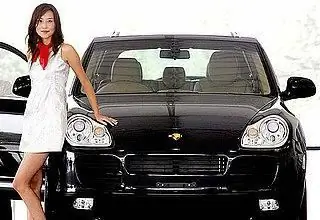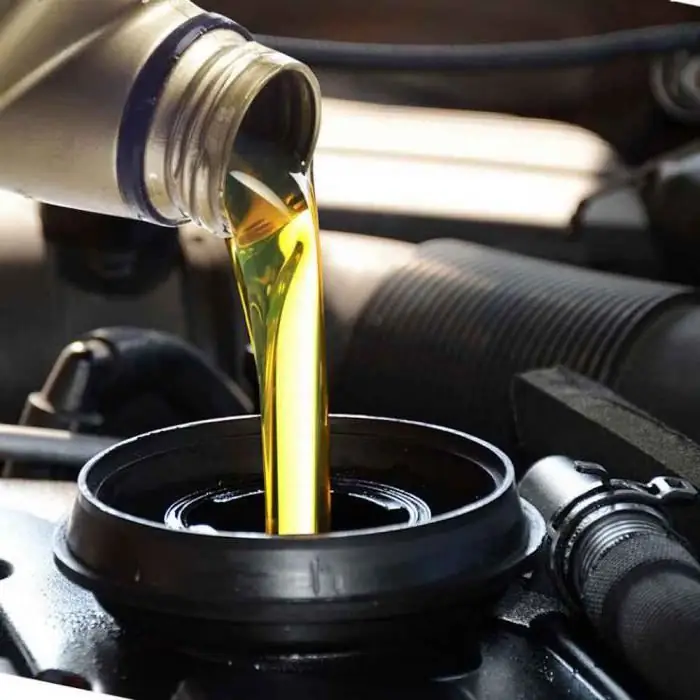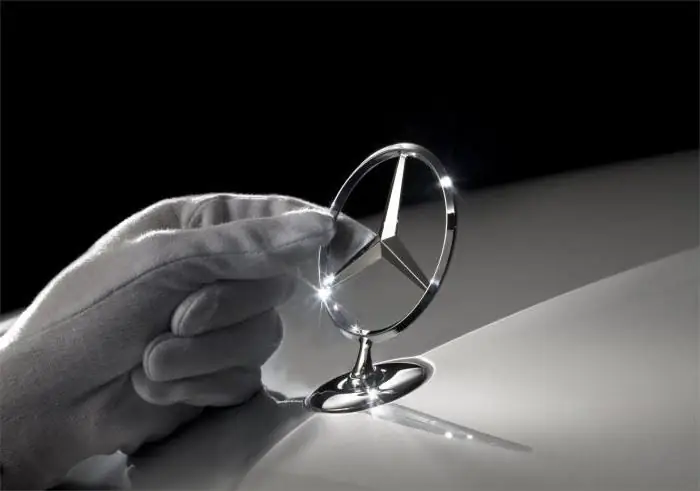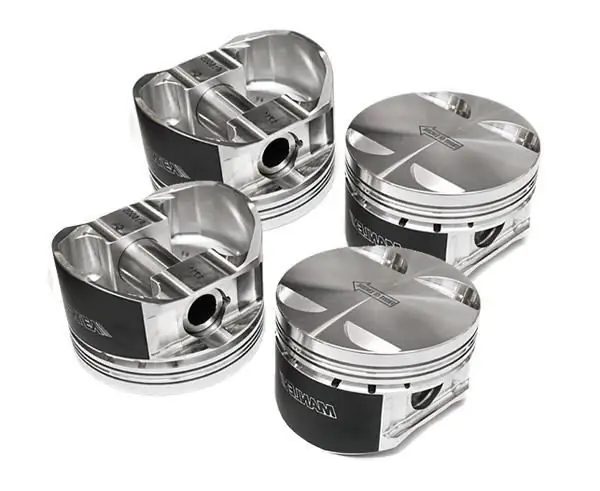2026 Author: Erin Ralphs | [email protected]. Last modified: 2025-01-22 21:14:12
Many technologies are being transferred to the automotive industry from motorsports. The solutions and parts used there are regarded as examples of reliability and performance, such as forged pistons. Automotive technology based on the use of these parts belongs to the examples of the use of sports solutions in civilian vehicles.
Definition
Pistons are represented by oval bushings moving in a vertical plane inside the cylinders and compressing the fuel-air mixture. According to the production technology, these parts are divided into cast and forged. Let's take a closer look at them.

Features of operation
Pistons of the first type are installed on most cars, as they perform well in everyday use and are sufficient for the needs of most users. Forged pistons are designed to work under increased loads, so they are used on sports and racing cars. That is, the design and features of this part are determined based on the conditions of its operation.
The most intensive factor affecting the pistons whenengine operation is temperature. It leads to the expansion of the metal, and uneven: it appears more parallel to the axis of the piston pin and less in the plane of the swing of the connecting rod. As a result, uneven contact of the piston with the cylinder occurs, as a result of which wear is accelerated. In critical cases, seizing occurs and the named parts get stuck, causing the engine to seize.
In addition, the pistons are affected by the force of inertia and the pressure created by the gases inside the cylinder.
Production technology
As the name suggests, cast pistons are made using metal casting technology. A silicon-aluminum alloy is used as the starting material. It is placed in a matrix, giving an oval shape. Then the part is adjusted to fit the cylinder. The skirt is made in an optimal barrel-shaped shape. To ensure resistance to high temperatures, the piston is filled from the inside with thermally compensating steel inserts
Unlike cast pistons, forged pistons are produced using stamping technology. Apply isothermal or liquid methods.
In the first case, the matrix is filled with molten metal and deformed at a certain speed using a punch. In this way a high quality workpiece is obtained. Its final processing is carried out mechanically.
Pre-prepared parts are used for isothermal stamping technology. They are obtained from a rod consisting of high-silicon aluminum, compressed through a die, which improves the structure of the metal,removing pores. Next, the workpiece heated in the matrix to 450 ° C is stamped using a hydraulic press using a high-speed method. This technology consists in applying a force of 250 tons to the matrix, while maintaining its temperature at a constant level. The result is precise, high-quality parts.

Main parameters
For a competent choice of the parts under consideration for a car, their parameters are correlated with the features of the engine. The following are the main characteristics of forged pistons:
- Engine model. The easiest way is to choose parts based on the brand of the motor, since manufacturers usually create such products for certain engine models. However, keep in mind that in this case they are designed for stock motors. That is, if any engine parameters are changed, for example, cylinders are bored out, the pistons designed for it will not fit. Then they are chosen according to other parameters (in this case, first of all, by size).
- Size. When selecting parts, you need to correlate their diameter with the diameter of the cylinder, taking into account thermal expansion.
- Compression ratio. The technical parameters of the pistons indicate a certain value of this indicator, for which they are designed. If the engine is not stock, this must also be taken into account.
- Mass. The value of this piston parameter is discussed below. In general, the lighter they are, the better.
- Power. The technical parameters of the pistons indicate the maximum power value for which their safety margin is sufficient. Parts should not be installedon an engine with high performance, since excess loads can lead to their accelerated wear and destruction.
Differences from cast pistons
Cast pistons are the standard analogue of the parts under consideration. They work properly on standard engines, but for many reasons they are not suitable for high-power power units. First, they are characterized by a high mass. Secondly, cast pistons have a suboptimal shape. Thirdly, these parts from the factory have defects represented by cavities, foreign inclusions, bubbles that are invisible and do not appear during normal operation in standard power units.
However, an increase in power leads to an increase in loads (temperature and pressure) on many elements of the car, primarily the engine. Under such conditions, these defects can lead to cracking or burning of the piston. This can happen, for example, after installing a crankshaft with a non-standard crank radius.

Benefits
The positive effect of forged pistons on engine parameters is primarily due to their low weight. The weight of such a part is on average 50 g less than the cast analogue. For example, VAZ forged pistons provide a weight saving of 400-600 g in the kit. This allows you to reduce the inertial forces inside the cylinder. As a result, speed increases, mechanical losses decrease, and power increases. In addition, inertial loads on other elements of the crank mechanism, such as the crankshaft, connecting rods andliners. That is, its total resource increases.
Also, forged pistons differ from cast ones in greater hardness. This indicator is 120-130 units, while for civilian analogues it is 80-90 units.
In addition, these parts are characterized by increased strength and resistance to temperature effects. So, in terms of thermal cyclic stability, they are 5-6 times superior to cast counterparts. Thanks to this, forged pistons withstand 2500 heating-cooling cycles, while civilian models only 400.
The reduced coefficient of thermal expansion made it possible to reduce the thermal gap between the cylinder and the piston to 0.05-0.06 mm.

Shape
Forged pistons are specially shaped to reduce weight. At the same time, the use of a T-profile does not affect oil consumption.
In addition, on the basis of uneven thermal expansion (to a greater extent parallel to the axis of the piston pin), some manufacturers produce oval models, perpendicular to the axis of the piston pin. Thus, when heated, the part acquires a round shape, in accordance with the shape of the cylinder. This ensures that they fit tightly to each other, evenly distributing the load over the surfaces and limiting the ingress of gases into the crankcase from the combustion chamber.

Flaws
The main disadvantage of forged pistons, in comparison with cast ones, is the high cost, both of the parts themselves and of the installation. The high cost of pistons is duethe complexity of production. In addition, you will have to seriously spend money on their installation. This is due to the fact that such complex work should be trusted only to professional craftsmen, and in this case it will be necessary not only to install, but also to customize the details.
In addition, forged pistons are said to make the car noisier than the original castings. However, this is true only for a cold car. This feature is explained by differences in expansion coefficients. Based on this, for forged pistons, the clearance with the cylinder wall is slightly increased. Therefore, a cold engine with such parts runs louder. However, after warming up, when the pistons expand, and therefore the temperature gap decreases, the noise subsides.
Application
As is clear from the above, forged pistons are used for uprated engines. These details affect many characteristics of power units. They improve both performance and reliability.

Relevance
The expediency of using forged pistons instead of cast ones is determined, first of all, by the peculiarities of using the car. Cast parts are enough for everyday use. Forged analogues are usually installed when tuning the engine. Moreover, even in this case, their use is not always advisable.
Such parts are most often used when boosting low-power engines. Standard parts of some sports motors have sufficient resource for non-extreme increasepower. Therefore, such parts for VAZ engines are most common (for example, forged pistons for Niva and forged pistons for Priora).

These parts are used not only for cars. You can install forged pistons on a motorcycle. Tuning sports models is also very common. Sometimes simple motorcycles are also modified. For example, some install forged pistons on the Ural.
Principles of application and cost
Often, the parts in question are used when installing a turbocharger. Moreover, in many cases, their use is a necessary condition for maintaining the engine resource, since this increases the temperature and loads on the parts, which often leads to burnout of the pistons. Forged turbo pistons are usually used in combination with a different crankshaft and H-shaped connecting rods.
In any case, during installation, it is necessary to ensure the cooling of the skirt and the bottom of the described part. To do this, install oil spray nozzles.
The price of Niva forged pistons (set), for example, starts at 4,500 rubles. For domestic motorcycles, they will cost less.
Recommended:
How to clean pistons from carbon deposits? Methods and means of cleaning pistons from carbon deposits

In order for the car engine to work properly for a long time, you need to monitor its condition, periodically cleaning the elements from carbon deposits and dirt. The hardest part to clean is the piston. After all, excessive mechanical stress can damage these parts
Brands of cars, their logos and characteristics. Car brands

The number of modern car brands is almost impossible to count. German, Japanese, Russian and other cars fill the market without interruption. When purchasing a new machine, it is necessary to carefully study each manufacturer and each brand. The article below provides a description of the most popular car brands
Subcompact car. Subcompact car brands

Small cars appeared during the period of economic stagnation of the second half of the 20th century, when gasoline prices rose steadily, maintenance of executive cars became more and more expensive, and class D cars themselves - (large family cars) and C - (average European ) were expensive
Can I mix synthetics and synthetics from different manufacturers? Is it possible to mix synthetics with synthetics from different manufacturers?

Quality lubrication is the key to reliable and long engine operation. Often, car owners brag about how often they change the oil in their car. But today we will not talk about replacement, but about topping up. If in the first case there are no questions (leaked, filled and drove off), then in the second case, the opinions of motorists differ. Is it possible to mix synthetics and synthetics from different manufacturers? Some say it's possible. Others say it's strictly forbidden. So let's try to figure this out
Badges of car brands and names. German, American and Chinese car brands and their badges

Badges of brands of cars - how diverse they are! With and without a name, intricate and simple, multi-color and plain … And all are very original and interesting. So, since German, American and Asian cars are the most common and in demand, then using the example of their best cars, the topic of the origin of emblems and names will be revealed

